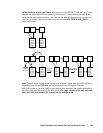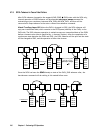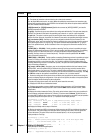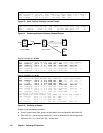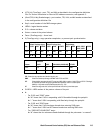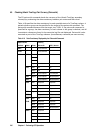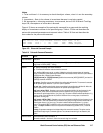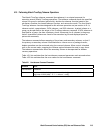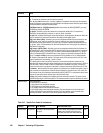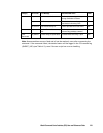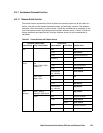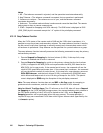
Hitachi Command Control Interface (CCI) User and Reference Guide 217
Notes:
1. To be confirmed = It is necessary to check the object volume, since it is not the secondary
volume.
2. Inconsistent = Data in the volume is inconsistent because it was being copied.
3. OK (assumption) = Mirroring consistency is not assured, but as S-VOL of Hitachi TrueCopy
Async/UR, the sequence of write data is ensured.
Figure 4.23 shows an example of the paircurchk c
ommand for a group and the resulting
display of inconsistent volumes in the specified group. Table 4.19 lists and describes the
pair
curchk command parameters and returned values. Table 4.20 lists and describes the
error
codes for the paircurchk command.
# paircurchk -g oradb
Group Pair vol Port targ# lun# LDEV# Volstatus Status Fence To be...
oradb oradb1 CL1-A 1 5 145 S-VOL PAIR NEVER Analyzed
oradb oradb2 CL1-A 1 6 146 S-VOL PSUS STATUS Suspected
Figure 4.23 Paircurchk Command Example
Table 4.19 Paircurchk Command Parameters
Parameter Value
Command Name paircurchk
Format paircurchk { -h ⎪ -q ⎪ -z ⎪ -g <group> ⎪ -d <pair Vol> ⎪-d[g] <raw_device> [MU#] ⎪
-d[g] <seq#> <LDEV#> [MU#] ⎪ -nomsg }
Options -h: Displays Help/Usage and version information.
-q: Terminates the interactive mode and exits the command.
-z or -zx (OpenVMS cannot use the -zx option): Makes the paircurchk command enter the interactive
mode. The -zx option guards performing of the HORCM in the interactive mode. When this option detects a
HORCM shut down, interactive mode terminates.
-I[H][M][instance#] or -I[TC][SI][instance#] Specifies the command as [HORC]/[HOMRCF], and used for
specifying Instance# of HORCM
-g <group>: Specifies a group name defined in the configuration definition file. The command is executed
for the specified group unless the -d <pair Vol> option is specified.
-d <pair Vol>: Specifies paired logical volume name defined in the configuration definition file. When this
option is specified, the command is executed for the specified paired logical volume.
-d[g] <raw_device> [MU#]: Searches a group on the configuration definition file (local instance) for the
specified raw_device, and if the specified raw_device is contained in the group, the target volume is
executed as the paired logical volume (-d) or group (-dg). This option is effective without specification of “-g
<group>“ option. If the specified the raw_device is contained in two or more groups, the command is
executed on the first group.
-d[g] <seq#> <LDEV#> [MU#]: Searches a group on the configuration definition file (local instance) for the
specified LDEV, and if the specified LDEV is contained in the group, the target volume is executed as the
paired logical volume (-d) or group (-dg). This option is effective without specification of “-g <group>“
option. If the specified LDEV is contained in two or more groups, the command is executed on the first
group. The <seq #> <LDEV #> values can be specified in hexadecimal (by addition of “0x “) or decimal
notation.
-nomsg: Suppresses messages to be displayed when this command is executed. This option must be
specified at the beginning of a command argument. The command execution log is not affected by this
option.
Returned values Normal termination (data is consistent): 0
Abnormal termination: other than 0, refer to the execution logs for error details.



